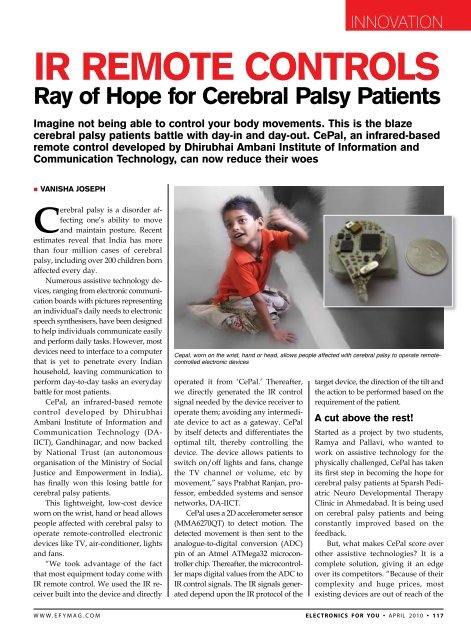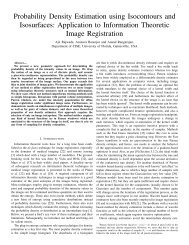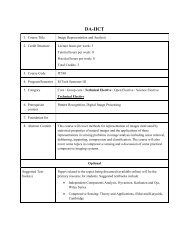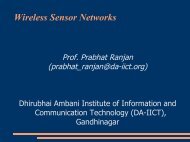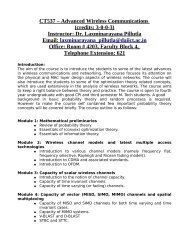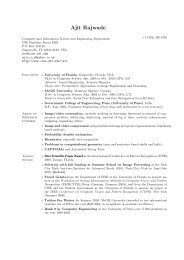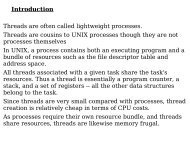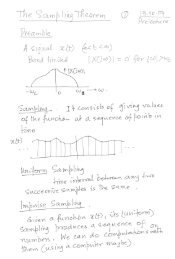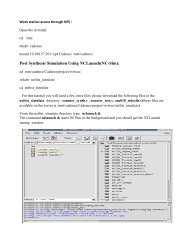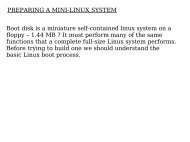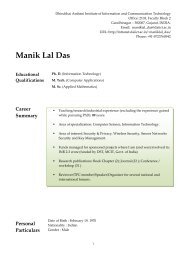iR Remote contRols - DAIICT Intranet - Dhirubhai Ambani Institute of ...
iR Remote contRols - DAIICT Intranet - Dhirubhai Ambani Institute of ...
iR Remote contRols - DAIICT Intranet - Dhirubhai Ambani Institute of ...
Create successful ePaper yourself
Turn your PDF publications into a flip-book with our unique Google optimized e-Paper software.
InnovatIon<br />
<strong>iR</strong> <strong>Remote</strong> <strong>contRols</strong><br />
Ray <strong>of</strong> hope for cerebral palsy patients<br />
imagine not being able to control your body movements. this is the blaze<br />
cerebral palsy patients battle with day-in and day-out. cepal, an infrared-based<br />
remote control developed by <strong>Dhirubhai</strong> ambani institute <strong>of</strong> information and<br />
communication technology, can now reduce their woes<br />
Vanisha Joseph<br />
Cerebral palsy is a disorder affecting<br />
one’s ability to move<br />
and maintain posture. Recent<br />
estimates reveal that India has more<br />
than four million cases <strong>of</strong> cerebral<br />
palsy, including over 200 children born<br />
affected every day.<br />
Numerous assistive technology devices,<br />
ranging from electronic communication<br />
boards with pictures representing<br />
an individual’s daily needs to electronic<br />
speech synthesisers, have been designed<br />
to help individuals communicate easily<br />
and perform daily tasks. However, most<br />
devices need to interface to a computer<br />
that is yet to penetrate every Indian<br />
household, leaving communication to<br />
perform day-to-day tasks an everyday<br />
battle for most patients.<br />
CePal, an infrared-based remote<br />
control developed by <strong>Dhirubhai</strong><br />
<strong>Ambani</strong> <strong>Institute</strong> <strong>of</strong> Information and<br />
Communication Technology (DA-<br />
IICT), Gandhinagar, and now backed<br />
by National Trust (an autonomous<br />
organisation <strong>of</strong> the Ministry <strong>of</strong> Social<br />
Justice and Empowerment in India),<br />
has finally won this losing battle for<br />
cerebral palsy patients.<br />
This lightweight, low-cost device<br />
worn on the wrist, hand or head allows<br />
people affected with cerebral palsy to<br />
operate remote-controlled electronic<br />
devices like TV, air-conditioner, lights<br />
and fans.<br />
“We took advantage <strong>of</strong> the fact<br />
that most equipment today come with<br />
IR remote control. We used the IR receiver<br />
built into the device and directly<br />
w w w . e f y m A g . c o m<br />
Cepal, worn on the wrist, hand or head, allows people affected with cerebral palsy to operate remotecontrolled<br />
electronic devices<br />
operated it from ‘CePal.’ Thereafter,<br />
we directly generated the IR control<br />
signal needed by the device receiver to<br />
operate them; avoiding any intermediate<br />
device to act as a gateway. CePal<br />
by itself detects and differentiates the<br />
optimal tilt, thereby controlling the<br />
device. The device allows patients to<br />
switch on/<strong>of</strong>f lights and fans, change<br />
the TV channel or volume, etc by<br />
movement,” says Prabhat Ranjan, pr<strong>of</strong>essor,<br />
embedded systems and sensor<br />
networks, DA-IICT.<br />
CePal uses a 2D accelerometer sensor<br />
(MMA6270QT) to detect motion. The<br />
detected movement is then sent to the<br />
analogue-to-digital conversion (ADC)<br />
pin <strong>of</strong> an Atmel ATMega32 microcontroller<br />
chip. Thereafter, the microcontroller<br />
maps digital values from the ADC to<br />
IR control signals. The IR signals generated<br />
depend upon the IR protocol <strong>of</strong> the<br />
target device, the direction <strong>of</strong> the tilt and<br />
the action to be performed based on the<br />
requirement <strong>of</strong> the patient.<br />
a cut above the rest!<br />
Started as a project by two students,<br />
Ramya and Pallavi, who wanted to<br />
work on assistive technology for the<br />
physically challenged, CePal has taken<br />
its first step in becoming the hope for<br />
cerebral palsy patients at Sparsh Pediatric<br />
Neuro Developmental Therapy<br />
Clinic in Ahmedabad. It is being used<br />
on cerebral palsy patients and being<br />
constantly improved based on the<br />
feedback.<br />
But, what makes CePal score over<br />
other assistive technologies? It is a<br />
complete solution, giving it an edge<br />
over its competitors. “Because <strong>of</strong> their<br />
complexity and huge prices, most<br />
existing devices are out <strong>of</strong> reach <strong>of</strong> the<br />
electronics for you • A p r i l 2 0 1 0 • 117
InnovatIon<br />
general population,” says pr<strong>of</strong>essor<br />
Ranjan, confident <strong>of</strong> conquering all the<br />
previous limitations.<br />
A complete solution. Taking advantage<br />
<strong>of</strong> MEMS technology-based<br />
accelerometer, CePal senses movements<br />
with high accuracy. “We kept<br />
in mind that cerebral palsy patients do<br />
not have very fine control over movements.<br />
We put logic in the firmware<br />
to detect the tilts,” explains pr<strong>of</strong>essor<br />
Ranjan. Considering each patient’s<br />
movement capability and behavioural<br />
pattern may differ, CePal is also able<br />
to tune parameters to match needs.<br />
“CePal provided flexibility in firmware<br />
to adjust to the needs, making it easy to<br />
be customisable at the user’s end,” says<br />
pr<strong>of</strong>essor Ranjan.<br />
Also, a work in progress would map<br />
the user-generated sound to meaningful<br />
voice outputs. A microphone is attached<br />
to the device that sends the sound input<br />
to the central processing unit via a<br />
wireless link, which is then mapped to<br />
prerecorded voice and corresponding<br />
meaningful response to be fed as the<br />
output to the speaker.<br />
Cost-effective. CePal is much<br />
cheaper than other assistive technology<br />
products in the market. Use <strong>of</strong> the<br />
latest hardware components, including<br />
MEMS-based sensors, has helped to<br />
minimise the number <strong>of</strong> components,<br />
reducing the overall costs. The use<br />
<strong>of</strong> Open Source technology has also<br />
made CePal cost-effective. “We used<br />
Open Source embedded system development<br />
tools and all development is<br />
done on Linux platform. In particular,<br />
we used GNU GCC cross compilers for<br />
firmware development, which helped<br />
to cut costs,” says pr<strong>of</strong>essor Ranjan.<br />
Easy to use. Usability <strong>of</strong> the device<br />
is <strong>of</strong> paramount importance for cerebral<br />
palsy patients and CePal ensures<br />
ease <strong>of</strong> use with its light weight. “We<br />
have used recent developments in<br />
technology to keep the weight low.<br />
The use <strong>of</strong> a microcontroller helped to<br />
reduce the component count. Further,<br />
the complete architecture is designed<br />
on a light-weight PCB to facilitate the<br />
user in using it without any hassle,”<br />
says pr<strong>of</strong>essor Ranjan.<br />
Road ahead<br />
National Trust will test CePal on a<br />
large scale in various parts <strong>of</strong> India. It<br />
has already won the HP Innovate Award<br />
in 2009. Pr<strong>of</strong>essor Ranjan and National<br />
Trust hope to take CePal to the next<br />
level, making it the guiding light for<br />
aged people.<br />
“We are looking at making CePal<br />
<strong>of</strong> great assistance to old people facing<br />
difficulty in the movement <strong>of</strong> limbs<br />
and people suffering from arthritis, paralysis<br />
and other physical impairments<br />
like carpal tunnel syndrome caused by<br />
excessive use <strong>of</strong> keyboard and mouse,”<br />
says pr<strong>of</strong>essor Ranjan. <br />
The author is a business correspondent at EFY<br />
Bengaluru<br />
1 1 8 • April 2 0 1 0 • electronics for you w w w . e f y m A g . c o m


